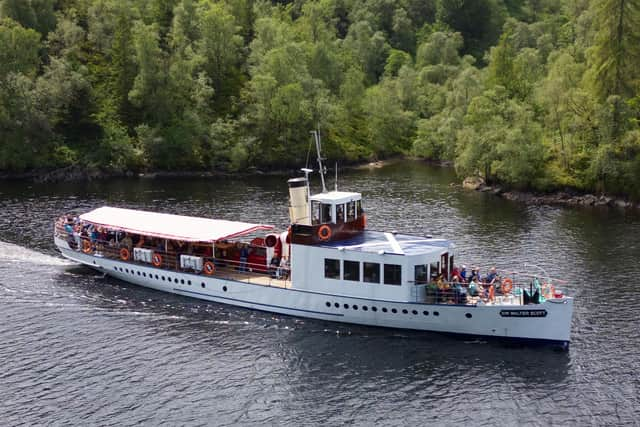Iconic Scotland steamship SS Sir Walter Scott returns to service on Loch Katrine after restoration
The world-famous SS Sir Walter Scott has transported tourists on Loch Katrine, in the Loch Lomond and The Trossachs National Park, for 120 years. The freshwater steamer was taken out of service in 2020 after an inspection revealed extensive cracks in its boilers.A global SOS – Save our Steamship – campaign to repair and restore the historic vessel raised £750,000 to ensure her return to active service in the "birthplace of Scottish tourism".
Nearly 100 passengers from around the world boarded the steamer for its first voyage in three years. They enjoyed fine weather as the ship departed in its stunning surroundings with a blast from its funnel.
Advertisement
Hide AdAdvertisement
Hide AdJames Fraser, chief executive of the Loch Katrine Steamship Trust, said: "Without the level of interest from the public we have had, we wouldn't be where we are today. That support became obvious the second that we launched our campaign, and people have kept with us for three years.


"We hope they will now come and enjoy the sailings that they have so greatly contributed to make happen."
Loch Katrine and the Trossachs is known as the birthplace of Scottish tourism following the publication of Sir Walter Scott's blockbuster poem "The Lady of the Lake" in 1810.
Scott, who also set his 1818 novel Rob Roy in the area, wrote in his poem: "So wondrous wild the whole might seem the scenery of a fairy dream".
The rapid growth in tourism sparked by Scott led to the introduction of passenger ferry boats and a number of passenger steamships in the 1800s. The SS Sir Walter Scott was built by William Denny and Brothers at Denny's shipyard at Dumbarton on the River Leven.
The 115 tonne, 110-foot-long vessel came into service on Loch Katrine in spring 1900, after trials on the Clyde in 1899. Originally powered by coal, the vessel now operates under more environmentally friendly biofuel using hydrogen and vegetable oil fuel.
The steamship, which carries up to 245 people on each of its three daily sightseeing cruises, received the necessary certification to carry passengers from the Marine Coastguard Agency on Tuesday evening.
Ken Henderson, chief engineer on board for the past seven years, said: "It's very nice indeed to see the ship back and running again. A lot of hard work has gone into making today happen and we are delighted to have passengers again."
Advertisement
Hide AdAdvertisement
Hide AdNigel and Lucy Hoad, both 69, from Ashford in Kent, were first in the queue. Nigel said: "This is our first time visiting this part of Scotland, but we knew all about the steamship and the campaign to save her. We feel very lucky to be the first passengers in three years."
Tom Wallace, operations manager at Trossachs Pier, where the steamer and other tourism cruises sail from, said the historic vessel had played a major role in the local economy. He said: "It's hugely important to have the steamship running again. There have been steamships on Loch Katrine since 1843 and it's been a key reason why people have come here.
"Over the last three years I've had numerous conversations with people who hold the SS Sir Walter Scott dearly to their heart. People have been constantly asking for updates and we are delighted to see passengers on board again.
"Now, with continued investment, there is no reason why she can't be sailing for another 120 years."
The SOS campaign initially sought to raise £500,000 to carry out repairs to the boilers and other restoration work. The final £750,000 target was met thanks to a huge response from the public, charities and a £130,000 National Lottery Heritage grant together with generous help from suppliers.
Paul Saunders, of the SS Sir Walter Scott Trust, said: "It was a daunting sum of money, especially on the back of Covid, and there were times we weren't sure today would come. It is really important that we maintain something so cherished and we are incredibly grateful to everyone who contributed."
Comments
Want to join the conversation? Please or to comment on this article.